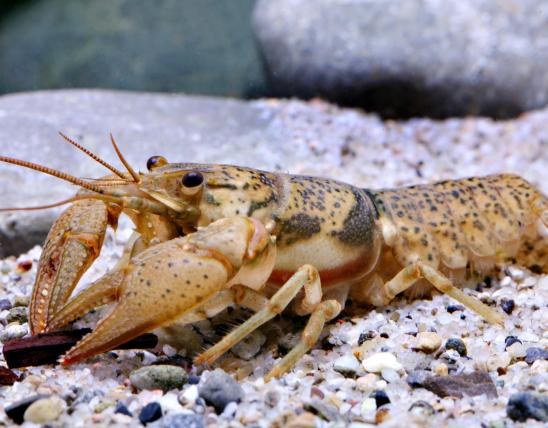
The woodland crayfish is a stout, reddish-tan to dark brown crayfish with numerous blackish specks and blotches on the pincers, carapace, and abdomen. A narrow, crescent-shaped dark band extends across the rear margin of the carapace and onto the first abdominal segment. The first abdominal segment is usually flanked by a pair of small whitish spots.
Similar species: The woodland crayfish is easily distinguished from other similar species within its range by its brown coloration and blotched and speckled color pattern. It somewhat resembles the Ozark crayfish, but the two species do not occur in the same river basins (except for the introduced populations).
Adult length: about 1 to 2½ inches.

This is the most abundant and generally distributed crayfish in the Black River and its tributaries. It occurs sparingly in the headwaters of Big River. It has been introduced into several streams (such as Stouts Creek and Carver Creek) in Iron and Madison counties. It is considered invasive where it has been introduced into the St. Francis River drainage.
Habitat and Conservation
Occurs in streams of all sizes, from the smallest headwater creeks to the largest Ozark rivers, but it is most abundant in creeks and small rivers. It seems to require permanent flow, silt-free, rocky and gravelly substrates, and low turbidity. This crayfish occupies cavities it digs beneath rocks and boulders, in riffles, in runs, and in silt-free rocky or gravelly pools.
Food
Crayfish are generally omnivores, eating a wide variety of plant and animal materials.
Status
The woodland crayfish is endemic to Missouri: it occurs within our borders and nowhere else in the world.
Even though the woodland crayfish is a Missouri endemic, it has been introduced outside its native range into the St. Francis River drainage, where it now occurs invasively. It has been implicated in declines of both the endemic Big Creek crayfish and the St. Francis River crayfish.
Life Cycle
The life history is similar to that of other Ozark stream crayfish. It breeds in late fall and early winter, and females release eggs in the spring. Females carry the eggs beneath their abdomens. By early May, the eggs have hatched and the females are carrying young. Females are secretive while carrying eggs and young and are rarely seen. Most woodland crayfish do not live much beyond their third summer.
Human Connections
In addition to feeding many types of wildlife, crayfish provide food for many species that humans hunt and fish. Crayfish commonly serve as fish bait, and many people eat crayfish, too. Crayfish are fascinating, colorful creatures and are part of our rich native heritage.
It can be hard for people to understand how a native Missouri species can also be invasive. The political borders of our state mean little to animals confined to aquatic habitats. Because crayfish and other aquatic animals usually cannot travel over land, they are often confined to specific river systems. When people move them artificially from one body of water to another that they didn't belong in naturally, they can become invasive, outcompeting or displacing the organisms native to that aquatic system.
Ecosystem Connections
Crayfish are an important link in the food chain between plants and other animals, breaking down plant materials that are resistant to decay. Crayfish in turn are an important food for many other animals. Presence of crayfish in a stream or pond usually indicates good water quality.





























